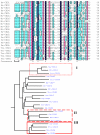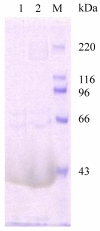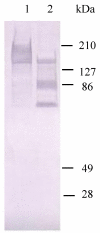Isolation and identification of insect intestinal mucin HaIIM86--the new target for Helicoverpa armigera biocontrol
- PMID: 21448339
- PMCID: PMC3065741
- DOI: 10.7150/ijbs.7.286
Isolation and identification of insect intestinal mucin HaIIM86--the new target for Helicoverpa armigera biocontrol
Abstract
There are many more glycoproteins in Helicoverpa armigera peritrophic membrane than midgut separated by SDS-PAGE analysis after Periodic acid-Schiff (PAS) and coomassie staining. The peritrophic membrane (PM) of H. armigera larvae contains about forty associated proteins. A cDNA library was constructed from H. armigera midgut mRNA to study the new target for pest biocontrol. An antiserum against Spodoptera exigua integral/total PM proteins cross reacted with several H. armigera PM proteins and was used to isolate a complete cDNA encoding an insect intestinal mucin (HaIIM86). The deduced protein sequence of the cDNA contained one potentially glycosylated, mucin-like domain, five cysteine-rich chitin-binding domains (CBDs) and two D-G rich regions. Mucin domain was lined between the first and second CBDs; the two additional D-G rich regions were proposed to internal reside at the amino terminus of the protein flanked by three cysteine-rich CBDs. HaIIM86 contains two D-G-rich tandem repeat domains flanked by cysteine-rich sequences in peritrophic membrane proteins which is not present in all the currently known PM proteins. Howerer the functions of D-G rich domains require further investigation. HaIIM86 was shown as 200 kDa protein by SDS-PAGE analysis and appeared to be associated with the PM. HaIIM86 has chitin-binding activity and can be degraded into 90 and 70 kDa by HaGV Enhancin in vivo. The finding has shown that HaIIM86 is the target substrate for enhancin and the potential target for pest control.
Keywords: Helicoverpa armigera; Peritrophic matrix; biocontrol; cDNA expression library; insect intestinal mucin.
© Ivyspring International Publisher.
Conflict of interest statement
CONFLICT OF INTERESTS: The authors have declared that no conflict of interest exists.
Figures










Similar articles
-
Characterization of an intestinal mucin from the peritrophic matrix of the diamondback moth, Plutella xylostella.Insect Mol Biol. 2003 Aug;12(4):333-43. doi: 10.1046/j.1365-2583.2003.00420.x. Insect Mol Biol. 2003. PMID: 12864913
-
Identification of two new peritrophic membrane proteins from larval Trichoplusia ni: structural characteristics and their functions in the protease rich insect gut.Insect Biochem Mol Biol. 2004 Mar;34(3):215-27. doi: 10.1016/j.ibmb.2003.10.001. Insect Biochem Mol Biol. 2004. PMID: 14871618
-
Modeling the structure of the type I peritrophic matrix: characterization of a Mamestra configurata intestinal mucin and a novel peritrophin containing 19 chitin binding domains.Insect Biochem Mol Biol. 2004 Oct;34(10):1101-15. doi: 10.1016/j.ibmb.2004.06.015. Insect Biochem Mol Biol. 2004. PMID: 15475304
-
Proteomic analysis of the peritrophic matrix from the gut of the caterpillar, Helicoverpa armigera.Insect Biochem Mol Biol. 2008 Oct;38(10):950-8. doi: 10.1016/j.ibmb.2008.07.009. Epub 2008 Aug 8. Insect Biochem Mol Biol. 2008. PMID: 18760362
-
Bacillus thuringiensis bel protein enhances the toxicity of Cry1Ac protein to Helicoverpa armigera larvae by degrading insect intestinal mucin.Appl Environ Microbiol. 2009 Aug;75(16):5237-43. doi: 10.1128/AEM.00532-09. Epub 2009 Jun 19. Appl Environ Microbiol. 2009. PMID: 19542344 Free PMC article.
Cited by
-
Infected insect gut reveals differentially expressed proteins for cellular redox, metal resistance and secretion system in Yersinia enterocolitica-Helicoverpa armigera pathogenic model.Biotechnol Lett. 2021 Sep;43(9):1845-1867. doi: 10.1007/s10529-021-03157-3. Epub 2021 Jun 24. Biotechnol Lett. 2021. PMID: 34165641
-
Peptidases and peptidase inhibitors in gut of caterpillars and in the latex of their host plants.Planta. 2015 Jan;241(1):167-78. doi: 10.1007/s00425-014-2174-3. Epub 2014 Sep 23. Planta. 2015. PMID: 25246317
-
Lepidopteran insects: emerging model organisms to study infection by enteropathogens.Folia Microbiol (Praha). 2023 Apr;68(2):181-196. doi: 10.1007/s12223-022-01014-y. Epub 2022 Nov 22. Folia Microbiol (Praha). 2023. PMID: 36417090 Review.
-
Identification and molecular characterization of a chitin-binding protein from the beet webworm, Loxostege sticticalis L.Int J Mol Sci. 2014 Oct 22;15(10):19147-61. doi: 10.3390/ijms151019147. Int J Mol Sci. 2014. PMID: 25340980 Free PMC article.
References
-
- Leanhe MJ. Peritrophic matrix structure and function. Annu Rev Entomol. 1997;42:525–50. - PubMed
-
- Tellam RL, Wijffels G, Willadsen P. Peritrophic matrix proteins. Insect Biochem Mol Biol. 1999;29:87–1011. - PubMed
-
- Ji HH, Yuan ZM. Peritrophic membrane: a potential target for biocontrol of pest insects. Acta Entomol Sin. 2005;48(6):968–974.
-
- Wang P, Granados RR. Molecular Cloning and Sequencing of a Novel Invertebrate Intestinal Mucin cDNA. J Biol Chem. 1997;272(26):16663–16669. - PubMed
Publication types
MeSH terms
Substances
LinkOut - more resources
Full Text Sources

